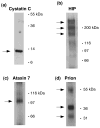Proteomics of dense core secretory vesicles reveal distinct protein categories for secretion of neuroeffectors for cell-cell communication
- PMID: 20695487
- PMCID: PMC2996463
- DOI: 10.1021/pr1003104
Proteomics of dense core secretory vesicles reveal distinct protein categories for secretion of neuroeffectors for cell-cell communication
Abstract
Regulated secretion of neurotransmitters and neurohumoral factors from dense core secretory vesicles provides essential neuroeffectors for cell-cell communication in the nervous and endocrine systems. This study provides comprehensive proteomic characterization of the categories of proteins in chromaffin dense core secretory vesicles that participate in cell-cell communication from the adrenal medulla. Proteomic studies were conducted by nano-HPLC Chip MS/MS tandem mass spectrometry. Results demonstrate that these secretory vesicles contain proteins of distinct functional categories consisting of neuropeptides and neurohumoral factors, protease systems, neurotransmitter enzymes and transporters, receptors, enzymes for biochemical processes, reduction/oxidation regulation, ATPases, protein folding, lipid biochemistry, signal transduction, exocytosis, calcium regulation, as well as structural and cell adhesion proteins. The secretory vesicle proteomic data identified 371 proteins in the soluble fraction and 384 membrane proteins, for a total of 686 distinct secretory vesicle proteins. Notably, these proteomic analyses illustrate the presence of several neurological disease-related proteins in these secretory vesicles, including huntingtin interacting protein, cystatin C, ataxin 7, and prion protein. Overall, these findings demonstrate that multiple protein categories participate in dense core secretory vesicles for production, storage, and secretion of bioactive neuroeffectors for cell-cell communication in health and disease.
Figures







Similar articles
-
Proteomics of neuroendocrine secretory vesicles reveal distinct functional systems for biosynthesis and exocytosis of peptide hormones and neurotransmitters.J Proteome Res. 2007 May;6(5):1652-65. doi: 10.1021/pr060503p. Epub 2007 Apr 5. J Proteome Res. 2007. PMID: 17408250
-
Mass spectrometry-based neuropeptidomics of secretory vesicles from human adrenal medullary pheochromocytoma reveals novel peptide products of prohormone processing.J Proteome Res. 2010 Oct 1;9(10):5065-75. doi: 10.1021/pr100358b. J Proteome Res. 2010. PMID: 20704348 Free PMC article.
-
Electron microscopic evidence for multiple types of secretory vesicles in bovine chromaffin cells.Gen Comp Endocrinol. 2001 Mar;121(3):261-77. doi: 10.1006/gcen.2000.7592. Gen Comp Endocrinol. 2001. PMID: 11254368
-
The adrenal chromaffin granule: a model for large dense core vesicles of endocrine and nervous tissue.J Anat. 1993 Oct;183 ( Pt 2)(Pt 2):237-52. J Anat. 1993. PMID: 8300414 Free PMC article. Review.
-
Biochemistry and molecular biology of the vesicular monoamine transporter from chromaffin granules.J Exp Biol. 1994 Nov;196:251-62. doi: 10.1242/jeb.196.1.251. J Exp Biol. 1994. PMID: 7823026 Review.
Cited by
-
Activation of Cytosolic Cathepsin B Activity in the Brain by Traumatic Brain Injury and Inhibition by the Neutral pH Selective Inhibitor Probe Z-Arg-Lys-AOMK.ACS Chem Neurosci. 2025 Apr 2;16(7):1297-1308. doi: 10.1021/acschemneuro.4c00577. Epub 2025 Mar 25. ACS Chem Neurosci. 2025. PMID: 40130579 Free PMC article.
-
Basement Membranes, Brittlestar Tendons, and Their Mechanical Adaptability.Biology (Basel). 2024 May 24;13(6):375. doi: 10.3390/biology13060375. Biology (Basel). 2024. PMID: 38927255 Free PMC article. Review.
-
Beta-amyloid peptides undergo regulated co-secretion with neuropeptide and catecholamine neurotransmitters.Peptides. 2013 Aug;46:126-35. doi: 10.1016/j.peptides.2013.04.020. Epub 2013 Jun 6. Peptides. 2013. PMID: 23747840 Free PMC article.
-
In vivo characterization of the maturation steps of a pigment dispersing factor neuropeptide precursor in the Drosophila circadian pacemaker neurons.Genetics. 2023 Aug 31;225(1):iyad118. doi: 10.1093/genetics/iyad118. Genetics. 2023. PMID: 37364299 Free PMC article.
-
Rapid SNARE-Mediated Fusion of Liposomes and Chromaffin Granules with Giant Unilamellar Vesicles.Biophys J. 2017 Sep 19;113(6):1251-1259. doi: 10.1016/j.bpj.2017.03.010. Epub 2017 Apr 8. Biophys J. 2017. PMID: 28400045 Free PMC article.
References
-
- Gainer H, Russell JT, Loh YP. The enzymology and intracellular organization of peptide precursor processing: the secretory vesicle hypothesis. Neuroendocrinology. 1985;40:171–84. - PubMed
-
- Kim T, Gondré-Lewis MC, Arnaoutova I, Loh YP. Dense-core secretory granule biogenesis. Physiology. 2006;21:124–33. - PubMed
-
- Scalettar BA. How neurosecretory vesicles release their cargo. Neuroscientist. 2006;12:164–76. - PubMed
Publication types
MeSH terms
Substances
Grants and funding
LinkOut - more resources
Full Text Sources

